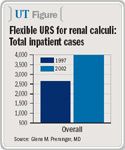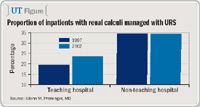Article
URS for renal stones: Data show changing trends in use
Author(s):
Cleveland-With the growing acceptance of flexible ureteroscopy at academic centers, this endoscopic technique as a treatment for renal stones has made fewer inroads into the practices of community urologists, data from a large U.S. inpatient database indicate. The reasons for the procedure's apparent lack of popularity in the community, at least in the inpatient setting, are unclear.

"We know in centers where there are fellowship-trained endourologists-people on the cutting edge of research-the use of ureteroscopic management of renal calculi is going to increase. But is that being translated into general urologic practice? With respect to inpatient flexible ureteroscopy, the answer would appear to be no, and the question is why," said Sean A. Pierre, MD, an endourology fellow at Duke University Medical Center, Durham, NC.

According to the database, 2,642 inpatient flexible ureteroscopies were performed in 1997, and 3,994 were performed in 2002-an overall increase of 51%. Perhaps not surprisingly, the vast majority of the procedures were performed in urban hospitals: 2,217 in 1997 and 3,445 in 2002. Regional variations in practice patterns were not significantly different, with hospitals in the South and Northeast reporting the most cases in 2002 (1,354 and 1,181, respectively), and those in the Midwest and West reporting fewer (909 and 550, respectively). The largest increase was seen in the Northeast, where the use of URS increased 61% between 1997 and 2002.
The study was not designed to examine factors that influence the use of ureteroscopic management of renal calculi, and the researchers were at a loss to explain the lack of growth of the technology in non-teaching centers. The finding might have been due to the fact that ureteroscopy is most commonly performed as an outpatient procedure, which the current database was unable to assess.
"We have this technology available, it's relatively inexpensive, it's very useful, and we're not seeing it [in community centers] as much as we would have expected," Dr. Pierre told Urology Times. "This is the first step in trying to investigate that phenomenon. The next step will be to get a sense of the outpatient procedures done, and that's a little bit trickier because the outpatient databases are not as comprehensive as the inpatient databases."















